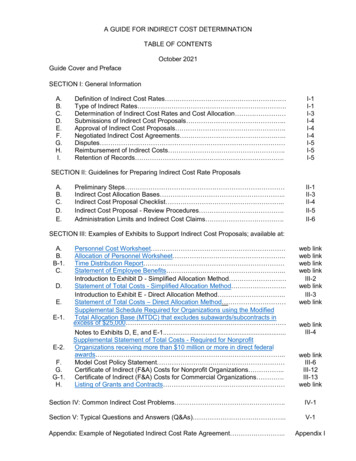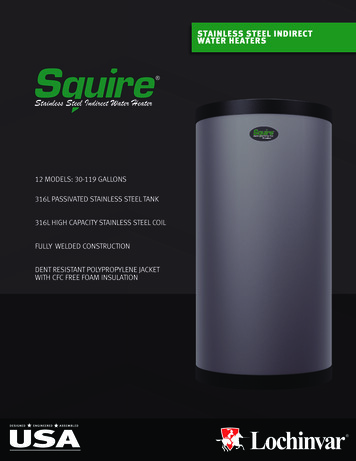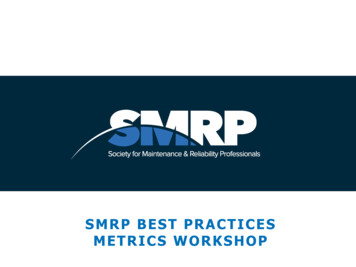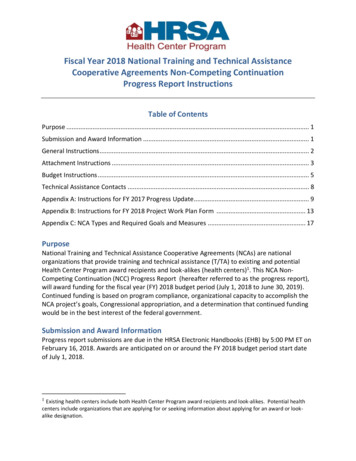
Transcription
A GUIDE FOR INDIRECT COST DETERMINATIONTABLE OF CONTENTSOctober 2021Guide Cover and PrefaceSECTION I: General InformationA.B.C.D.E.F.G.H.I.Definition of Indirect Cost Rates Type of Indirect Rates .Determination of Indirect Cost Rates and Cost Allocation Submissions of Indirect Cost Proposals .Approval of Indirect Cost Proposals .Negotiated Indirect Cost Agreements .Disputes Reimbursement of Indirect Costs .Retention of Records .I-1I-1I-3I-4I-4I-4I-5I-5I-5SECTION II: Guidelines for Preparing Indirect Cost Rate ProposalsA.B.C.D.E.Preliminary Steps Indirect Cost Allocation Bases .Indirect Cost Proposal Checklist .Indirect Cost Proposal - Review Procedures .Administration Limits and Indirect Cost Claims .II-1II-3II-4II-5II-6SECTION III: Examples of Exhibits to Support Indirect Cost Proposals; available at:A.B.B-1.C.D.E.E-1.E-2.F.G.G-1.H.Personnel Cost Worksheet Allocation of Personnel Worksheet .Time Distribution Report Statement of Employee Benefits .Introduction to Exhibit D - Simplified Allocation Method Statement of Total Costs - Simplified Allocation Method .Introduction to Exhibit E - Direct Allocation Method .Statement of Total Costs – Direct Allocation Method Supplemental Schedule Required for Organizations using the ModifiedTotal Allocation Base (MTDC) that excludes subawards/subcontracts inexcess of 25,000 Notes to Exhibits D, E, and E-1.Supplemental Statement of Total Costs - Required for NonprofitOrganizations receiving more than 10 million or more in direct federalawards .Model Cost Policy Statement Certificate of Indirect (F&A) Costs for Nonprofit Organizations .Certificate of Indirect (F&A) Costs for Commercial Organizations .Listing of Grants and Contracts web linkweb linkweb linkweb linkIII-2web linkIII-3web linkweb linkIII-4web linkIII-6III-12III-13web linkSection IV: Common Indirect Cost Problems .IV-1Section V: Typical Questions and Answers (Q&As) .V-1Appendix: Example of Negotiated Indirect Cost Rate Agreement .Appendix I
A Guide forIndirect Cost Rate DeterminationBased on the Cost Principles and ProceduresRequired by 2 CFR Part 200, Subpart E & Appendix IVfor Non-profit Organizationsand by the Federal Acquisition Regulation Parts 31.2 and 42.7 for Commercial OrganizationsU.S. Department of LaborCost & Price Determination DivisionOffice of Strategy & Administration/OSPE/OASAMFor additional Information: Contact UsOctober 2021
PREFACEThis Guide has been prepared by the Cost & Price Determination Division (CPDD), to assist nonprofit and commercial organizations (non-Federal entities) in understanding the requirements forthe determination of indirect costs on cost reimbursable grants, contracts, and otheragreements awarded by the U.S. Department of Labor (DOL).An indirect cost rate is established on the basis of a Federally approved indirect cost rateproposal and supporting documentation submitted by organizations. Indirect costs allocable toDOL programs should be reimbursed if an organization has a Federally approvedrate. Reimbursement, however, is subject to any administrative limitations established in thegrants and/or contracts.The formats provided in this guide are the preferred formats of CPDD, but are not strictlyrequired, as some other formats may be acceptable. The actual content of the exhibits andsamples may vary between organizations.An indirect cost rate is simply a device for determining fairly and conveniently within theboundaries of sound administrative principles, what proportion of indirect cost each programshould bear. Note that indirect costs are incurred for common or joint objectives and cannot bereadily identified with a particular grant, contract or other activity of the organization. An indirectcost rate is the ratio between the total indirect expenses and some direct cost base. The indirectcost allocation methods used by each organization depend on its own structure, programfunctions, and accounting system.Prior to the preparation of an indirect cost rate proposal and supporting documentation;and, to be in accordance with the procedures described in this Guide, the applicable costprinciples should be reviewed.2 CFR Part 200, Subpart E & Appendix IV, establish the Federal requirements for thedetermination of allowable and unallowable direct and indirect costs for nonprofit organizations.The Federal Acquisition Regulations (FAR), Part 31.2, “Contracts with CommercialOrganizations”, establishes the Federal requirements for the determination of allowable andunallowable direct and indirect costs. FAR Part 42.7 “Indirect Cost rates” provides guidance oncognizance for indirect rate determination among other relevant topics. Commercial entities mustfollow these regulations.Access to the above regulations is available our CPDD's website.The Office of Inspector General randomly audits indirect cost rate proposals. The results of theiraudits have indicated a need for better controls and procedures on charging indirect costs toFederal awards. Section IV of this Guide, provides examples of problems disclosed during suchaudits which are presented here to help avoid future problems.All inquiries for additional information should be directed to CPDD. Visit our Contact Us websitefor details or send an email to OSPE-CPDD@dol.gov.VICTOR M. LOPEZChiefCost & Price Determination Division
Section IGeneral InformationThis section includes the following information:A.B.C.D.E.F.G.H.I.Definition of Indirect CostsTypes of Indirect RatesDetermination of Indirect Cost Rates and Cost AllocationSubmissions of Indirect Cost ProposalsApproval of Indirect Cost ProposalsNegotiated Indirect Cost Rate Agreement (NICRA)DisputesReimbursement of Indirect CostsRetention of RecordsA. Definition of Indirect CostsAccording to 2 CFR Part 200.1, indirect costs or otherwise indirect F&A costs are define as:§200.56 Indirect (facilities & administrative (F&A)) costs.Indirect (F&A) costs means those costs incurred for a common or joint purposebenefitting more than one cost objective, and not readily assignable to the cost objectivesspecifically benefitted, without effort disproportionate to the results achieved. To facilitateequitable distribution of indirect expenses to the cost objectives served, it may benecessary to establish a number of pools of indirect (F&A) costs. Indirect (F&A) costpools should be distributed to benefitted cost objectives on bases that will produce anequitable result in consideration of relative benefits derived.B. Definition and types of Indirect RatesAn indirect cost rate is simply a device for determining fairly and conveniently within theboundaries of sound administrative principles, what proportion of indirect cost each programshould bear. An indirect cost rate is the ratio between the total indirect expenses and some directcost base.The CPDD typically negotiates provisional and final indirect cost rates. There are alsopredetermined and fixed rates which may be suitable for certain negotiation scenarios andorganizations. All of these types of rates are described in §2 CFR, Appendix IV, C.1. See alsobelow:1. Provisional rate or billing rate means a temporary indirect cost rate applicable to aspecified period which is used for funding, interim reimbursement, and reportingindirect costs on awards pending the establishment of a final rate for the period.2. Final rate means an indirect cost rate applicable to a specified past period which isbased on the actual costs of the period. A final rate is not subject to adjustment.Note that a final indirect cost rate is established after an organization's actual costsare known, typically a fiscal year. Once established, a final indirect cost rate is usedto adjust the indirect costs claimed.The use of provisional and final rates will likely result in final auditedexpenditures being higher or lower than those reported for awards, which areI-1
terminated during the organization's fiscal year. A final rate may be issued asa provisional rate in the ensuing year, adjusted for anticipated changes infunding levels or costs.3.Predetermined Rate: Means an indirect cost rate, applicable to a specified current orfuture period, usually the organization's fiscal year. The rate is based on an estimateof the costs to be incurred during the period. A predetermined rate is not subject toadjustment. A predetermined rate may be used on awards where there is reasonableassurance that the rate is not likely to exceed a rate based on the organization'sactual costs,4.Fixed Rates with carry-forward: Means an indirect cost rate which has the samecharacteristics as a predetermined rate, except that the difference between theestimated costs and the actual costs of the period covered by the rate is carriedforward as an adjustment to the rate computation of a subsequent period.Provisional and final rates are preferred by most nonprofit organizations for the followingreasons:a) Actual indirect costs are allocated to program objectives in the year incurred, creatingaccurate cost information;b) There are no prior year indirect costs carried into a future year to burden newor continuing funding;c) All indirect costs are properly funded in the fiscal year incurred, creating noprofit or loss for the organization;d) The organization's accounting system must determine actual costs eachyear, a capability that ultimately must exist to synchronize accounting,budgeting, and cost allocation; ande) The actual cost of services or programs is determined annually and istherefore available for purposes of internal management and informedbudgeting.10% De minimis rate – 2 CFR 200.414(f) provides for this type of rate, see descriptionbelow. It is noted that this office does not approve this type of rate. It is up to the grantofficer approval.In addition to the procedures outlined in the appendices in paragraph (e) of thissection, any non-Federal entity that does not have a current negotiated (includingprovisional) rate, except for those non-Federal entities described in appendix VIIto this part, paragraph D.1.b, may elect to charge a de minimis rate of 10% ofmodified total direct costs (MTDC) which may be used indefinitely. Nodocumentation is required to justify the 10% de minimis indirect cost rate. Asdescribed in § 200.403, costs must be consistently charged as either indirect ordirect costs, but may not be double charged or inconsistently charged as both. Ifchosen, this methodology once elected must be used consistently for all Federalawards until such time as a non-Federal entity chooses to negotiate for a rate,which the non-Federal entity may apply to do at any time.According to §200.1, MTDC is defined as:MTDC means all direct salaries and wages, applicable fringe benefits, materialsand supplies, services, travel, and subawards and subcontracts up to the first 25,000 of each subaward or subcontract (regardless of the period ofperformance of the subawards and subcontracts under the award). MTDCexcludes equipment, capital expenditures, charges for patient care, rental costs,tuition remission, scholarships and fellowships, participant support costs and theI-2
portion of each subaward and subcontract in excess of 25,000. Other items mayonly be excluded when necessary to avoid a serious inequity in the distribution ofindirect costs, and with the approval of the cognizant agency for indirect costs.Possible 4-year extension of previously negotiated rates - 2 CFR 200.414(g), states thefollowing:(g) Any non-Federal entity that has a current federally-negotiated indirect costrate may apply for a one-time extension of the rates in that agreement for aperiod of up to four years. This extension will be subject to the review andapproval of the cognizant agency for indirect costs. If an extension is granted thenon-Federal entity may not request a rate review until the extension period ends.At the end of the 4-year extension, the non-Federal entity must re-apply tonegotiate a rate. Subsequent one-time extensions (up to four years) arepermitted if a renegotiation is completed between each extension request.CPDD’s policy – We will consider non-Federal entities requests for these extensions on acase by case basis.C. Determination of Indirect Cost Rates and Cost AllocationNon – Profits - The three basic methods for calculating indirect cost rates are explained in 2CFR, Appendix IV, B2 through B4. These methods are: Simplified,Multiple Rate, andDirect Allocation methods.Examples of the Simplified and Direct Allocation methods are shown on Exhibits D and E inSection III of this Guide.2 CFR, Appendix IV, B.5., also provides for the use of Special Indirect Cost Rates. A singleindirect cost rate for all activities of the organization may not be appropriate when work under theFederal program is conducted in an offsite location and the level of administrative support isdifferent than other programs.For an organization that receives more than 10 million in Federal funding of direct costs in afiscal year, a breakout of the indirect costs into two components; Facilities and Administration,as defined below, is required. The rate shall be stated as a percentage which the amount ofFacilities and Administration is, of the applicable distribution base used for each component.Each indirect cost rate negotiation agreement shall identify the development of each indirect costpool component as well as the overall indirect cost rate. See definitions below and exampleavailable in Exhibit E-2 of Section III of this guide.1. "Facilities" is defined as depreciation and use allowances on buildings, equipment andcapital improvements; interest on debt associated with certain buildings, equipment andcapital improvements; and operations and maintenance expenses.2. "Administration" is defined as general administration and general expenses such as thedirector's office, accounting, personnel, library expenses and all other types ofexpenditures not listed specifically under one of the subcategories of "Facilities",(including cross allocations from other pools, where applicable).Commercial Organizations – The above requirement is not applicable to commercialorganizations.I-3
D. Submissions of Indirect Cost ProposalsPrior to the preparation of an indirect cost rate proposal and supporting documentation, thefollowing cost principles should be review to determine if the costs proposed are reasonable,allowable, and allocable to the Federal government:Non-profit Organizations2 CFR Part 200, Subpart E & Appendix IVCommercial OrganizationsFederal Acquisition Regulation (Part 31.2 &42.7)An incurred cost, or final indirect cost rate proposal, together with the supporting documentationlisted in Section II.C., must be developed and submitted on an annual basis to the CPDD no laterthan six months after the close of the organization's fiscal year, unless an exception is approvedby the CPDD. For organizations with no prior approved indirect cost rate, a budget (orprovisional) proposal must be submitted no later than three months after the effective date of theDOL award.Indirect cost rate proposals need to be submitted via email to the assigned cost negotiator (seeour Contact Us website) or to the following email address: OSPE-CPDD@dol.gov.Refer to Section II-4 for checklist of required documentation, and Section III for Examples ofExhibits to support the indirect cost proposal.E. Approval of Indirect Cost ProposalsUnless different arrangements are agreed to by the agencies concerned, the Federal agency withthe largest dollar value of awards with an organization will be designated as the cognizant agencyfor the negotiation and approval of the indirect cost rates.The CPDD will negotiate and approve indirect cost rates when the DOL is the cognizant Federalagency. Indirect costs can only be charged to a grant or contract based on a Negotiated IndirectCost Rate Agreement (NICRA) approved by the CPDD. However, the approval of indirect costsby the CPDD is not intended to identify the circumstances or dictate the extent of Federalparticipation in the financing of particular grants or contracts.F. Negotiated Indirect Cost Rate Agreement (NICRA)The approval will be formalized by a rate agreement signed by the Chief, CPDD (or its designee)and an authorized representative of the organization. Each agreement will include:1. The approved rate(s) and information directly related to the use of the rates, e.g.,type of rate, effective period, and distribution base;2. The treatment of fringe benefits as either direct and/or indirect costs3. General terms and conditions; and4. Special remarks, e.g., composition of the indirect cost pool.An example of an indirect cost agreement is provided in Appendix I of this Guide.I-4
G. DisputesWhen the CPDD and the non-Federal entity cannot reach an agreement on an acceptableindirect cost rate, the CPDD will make a unilateral determination of the rate(s) and will notify theorganization. The CPDD or the grant/contract officer will advise the organization of its right toappeal the determination and will provide information about the appeal procedures to follow uponrequest.H. Reimbursement of Indirect CostsReimbursement of indirect cost is subject to the submission of an indirect cost rate proposal (seepart D of this Section), availability of funds, statutory and administrative restrictions, and theapproval of the DOL Grant/Contract Officer or authorized representative.Certain DOL grants and contracts include ceilings for reimbursement of indirect costs and/oradministrative costs. When the amount otherwise allocable as indirect costs exceeds the amountallowable under the terms and conditions of the grant/contract agreement, the excess amountmay be used to satisfy cost-sharing or matching requirements. However, the differences may notbe shifted to another Federal grant or contract unless specifically authorized by legislation.I. Retention of RecordsIf the indirect cost rate proposal, cost allocation plan, or other computation is to be submitted tothe Federal Government (or to the grantee) to form the basis for negotiation of a rate(s), there isthe 3-year retention requirement from the date of such submission.If the indirect cost rate proposal, cost allocation plan, or other computation is not required to besubmitted to the Federal Government for negotiation purposes, then the 3-year retention periodfor its supporting records starts from the end of the fiscal year (or other accounting period)covered by the indirect cost rate proposal, cost allocation plan, or other computation.For regulatory basis on “retention of records” for non-profits, see 2 CFR 200.334 (f)(1)(2).For regulatory basis on “retention of records” for commercial organizations, see the FederalAcquisition Regulation Part 4 – Administrative Matters, Subpart 4.703 Policy.If any litigation, claim or audit is started before the expiration of the 3-year period, the recordsshall be retained until all litigations, claims or audit findings involving the records have beenresolved.I-5
SECTION IIGuidelines for Preparing Indirect Cost Rate ProposalsNote: Non Federal entities (Grantees/Contractors) must have an established accounting system prior tobeing awarded a grant or contract from DOL or any other agency in the Federal government. Theaccounting system must provide adequate internal controls to safeguard assets, insure fundaccountability by cost category, assure accounting data accuracy and reliability, promote operatingefficiency, and comply with Government requirements and accounting procedures.For reference purposes, see the Standards for Financial Management in 2 CFR.302 for nonprofitorganizations. Also, see evaluation of accounting systems referenced in FAR Part 9.106 and theStandard Form 1408 applicable to contractors.--This section includes the following information:A.B.C.D.E.A.Preliminary StepsIndirect Cost Allocation BasesIndirect Cost Rate Proposal ChecklistIndirect Cost Proposal – Review ProceduresAdministration Limits and Indirect Cost ClaimsPreliminary StepsPrior to the preparation of an indirect cost rate proposal and supporting documentation, the applicablecost principles should be thoroughly reviewed.Nonprofit organizations must follow 2 CFR Part 200, Subpart E & Appendix IV.Commercial organizations must follow the Federal Acquisition Regulation Parts 31.2 and 42.7.If indirect costs are allowed in the grant or contract award, the entity will then be ready to prepare anindirect cost rate proposal based on the following steps:Organization Review1. 2.If one does not already exist, prepare a formal organizational chart(s), or a rough draftversion, and provide any information or material explaining the various services and/orfunctions for each unit.Determine which units are indirect (administrative) functions of the organization.Determine the services that are allowable and allocable to Federal grants and contracts perthe applicable cost principles.Review Federal and Non-Federal Funding Review the Federal and non-Federal outlays to determine programs being funded; verify withthe appropriate staff.Prepare a list of all funded programs in detail as to the amount or percent of reimbursement ofdirect and indirect cost and any restrictions or references to statutes or regulations.Determine at what organizational level the various funded programs apply. Illustrate the list offunded programs on a copy of the organization chart.II-1
Contact the Federal agency which provides the most funds regarding the procedures for thesubmission, review and approval of indirect cost rates.Review the Accounting Structure3. Obtain a chart of accounts, or some other list of accounts for your organization, in which theactual dollars expended can be related to various programs and/or organization structure.Reconcile the accounting structure to the organization chart.If necessary, determine changes to implement an indirect cost rate system of billing.Prepare a Cost Policy Statement4. Develop a written policy that outlines the costs considered as direct, the costs considered tobe indirect, and the rationale to support those costs. A sample cost policy statement isavailable in Section III.Prepare an Indirect Cost Rate Proposal5. Determine which method is best for the organization, i.e., direct cost allocation or simplified,and whether special indirect cost rates are required, i.e. on-site, off-site, fringe benefit rate forfull-time vs. part-time. In selecting the appropriate method, the organization should considerthe following:a.b.c.d.Organizational structureLevel of Federal fundingReports generated from their accounting systemAvailability of data on square footage, number of transactions, employees, purchaseorders, etc.e. Additional effort and cost required to achieve a greater degree of accuracy. 6.Prepare the indirect cost rate proposal following the examples shown in Section III.Prepare a Certificate of Indirect Costs and have signed by the Executive Director, or otherdesignated official with organization’s signature authority (see Section III for a sample).Compile all remaining documentation required by the cognizant Federal agency. Non-federalentities that need submit proposals to CPDD should follow the checklist on page II-4.Reconcile the indirect cost rate proposal to the audited (if applicable) financial statements.Obtain Cognizant Agency Approval Submit proposal to cognizant agency;Cognizant agency may follow up after review with questions, and/or concerns – and mayrequest additional documentation, and/or narrative responses, in support of the proposal.Document meeting and/or telephone conversations, e-mails and faxes.Make any agreed upon changes, and submit any revised, and/or supporting documentationrequested by cognizant agency.Receive Negotiated Indirect Cost Rate Agreement.Implementation7. Prepare claims using the lower of either the approved rate, or the ceiling rate for your grant orcontract.Use final, predetermined, or fixed with carry forward rate(s) included in indirect cost rateagreement for close-out purposes.Maintain documentation for audit purposes – see page I-4 for Retention of Records.II-2
B.Indirect Cost Rate Allocation BasesThe following allocation bases are acceptable examples for use when indirect costs are allocated tobenefiting cost objectives by means of an indirect cost rate. Typical allocation bases are below tocalculate an indirect cost rate. See also see Exhibit E for Suggested Allocation Bases on non-labor costs.1. Direct salaries and wages including (or excluding) all fringe benefits.2. Direct salaries and wages including vacation, holiday, sick pay, and other paid absencesbut excluding all other fringe benefits.3. According to 2 CFR §200.1, Modified Total Direct Costs (MTDC), is defined as:All direct salaries and wages, applicable fringe benefits, materials and supplies,services, travel, and subawards and subcontracts up to the first 25,000 of eachsubaward or subcontract (regardless of the period of performance of thesubawards and subcontracts under the award).MTDC excludes equipment, capital expenditures, charges for patient care, rentalcosts, tuition remission, scholarships and fellowships, participant support costsand the portion of each subaward in excess of 25,000.4. For commercial entities, total costs less G&A expenses.The selection of an appropriate allocation method should be based upon the commonality of costs to allcost objectives. In general, a correlation exists between the incurrence of administrative effort with theexpenditures for direct labor. In most cases, a direct labor base will produce an equitable distribution ofindirect costs. However, where the ratio of direct labor to total direct costs varies significantly fromprogram to program, an "adjusted" total direct cost base should be used in allocating costs to benefitingprograms.The proposed allocation base(s) is subject to negotiation and approval by CPDD. Any modifications tothe “approved” base require prior written approval. Failure to obtain such written approval may result incost disallowances.C.Indirect Cost Rate Proposal Checklist – non-profit and commercial organizationsSee next page.II-3
Note: Please submit separate electronic files as part of proposal corresponding with checklistitems to your assigned cost negotiator or to this office at OSPE-CPDD@dol.gov.Ensure that no personal identifiable information (PII; Ex. social security numbers) issubmitted with the proposal.For item # 2, please submit one Excel workbook or similar format.Examples of exhibits supporting the proposal are available in Section III of this guide.Indirect Cost Proposal ChecklistNon-Profits and Commercial Organizations1.2.Administrative documents:1a. Organizational chart,1b. Nonprofits - Narrative explaining compliance with 2 CFR §200.430(a)(1)(2) & (3) and the standards fordocumentation of personnel expenses.Commercial - Narrative explaining the standards for documentation of personnel expenses incompliance with FAR 9.106-4 and SF-1408.For both entities, an example of an employee timesheet for a pay period, providing for distribution ofhours to direct/indirect functions.1c. Signed Cost Policy Statement.An indirect cost rate proposal(s) providing the following:2a. Personnel Costs Worksheet, including fringe benefits breakdown.2b. Allocation of Personnel Worksheet, providing indirect/direct time charges.2c. Fringe Benefits Worksheet,2d. Statement of Total Costs, supporting the indirect and direct costs incurred by expense category,identified by Federal agency, specific government grant, contract, and other non-governmentactivities.2e. Statement of Indirect Costs, including indirect cost pool(s), allocation base(s), and indirect cost rate(s)proposed.3.Audited financial statements, if available. If audited financial statements are not available, IRS Form 990(non-profits) or compilation/review financial statements (for-profits) for the final rate proposal. Approvedbudget for provisional proposal, if needed. Note: The Statement of Total Costs (2d. above) must reconcileto Financial Statements. If not, please provide a reconciliation statement.4.Certification that the indirect cost rate proposal was prepared in a manner consistent with the applicablecost principles set forth in 2 CFR Part 200, Subpart E & Appendix IV for non-profits, or the FederalAcquisition Regulation (Part 31) for commercial organizations. The certifications should be signed by thePresident/Executive Director, or Comptroller/CFO.5.A listing of grants and contracts by Federal agency, subagency, program office funding source, awardamount, period of performance, and the indirect cost (overhead) limitations (if any) applicable to each,such as, ceiling rates or amounts restricted by administrative or statutory regulations, applicable to theperiod(s) of the proposal(s). This listing must be supported with copies of the approved federal grants orcontracts notification awards (1st page).Note: For organizations receiving funding from DOL's Employment and Training Administration (ETA), pleaseensure that the proposed individual compensation (salary and bonus) complies with the salary limitationsestablished in ETA’s TEGL 5-06. The Office of Job Corps has similar salary limitations. See our website foradditional details. Two additional proposal worksheets (see 2b. and 2d above) may be needed to show ETAand/or Job Corps rates reflecting unallowable compensat
cost rate is the ratio between the total indirect expenses and some direct cost base. The indirect cost allocation methods used by each organization depend on its own structure, program functions, and accounting system. Prior to the preparation of an indirect










